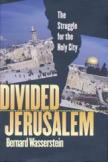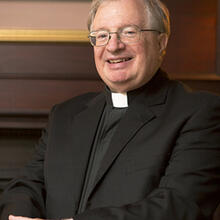Home to Three
Its name evokes peace, but Jerusalem is a city in constant turmoil, where controversy often turns deadly. In 1996, when Prime Minister Benjamin Netanyahu opened the Hasmonean tunnel under the Haram al Sherif, the Muslim sanctuary above the Temple Mount, more than two weeks of hard fighting between Palestinians and Israelis ensued. In September 2000, when Ariel Sharon, in the company of more than 1,000 soldiers and police, visited the Haram al Sherif, he knowingly violated a tabu, in place since the Israeli occupation of East Jerusalem in 1967, that prohibits Jews from entering the third holiest shrine of Islam to pray.
Bernard Wasserstein is a professor of history at the University of Glasgow and president of the Jewish Historical Society of England. Divided Jerusalem is a history of the diplomacy over Jerusalem beginning with the 1830’s. It is a valuable addition to the voluminous literature on the holy city. Wasserstein’s story begins with rivalries and intrigues brought about by the appearance of European consuls in Jerusalem in the mid-19th century. As the Ottoman Empire demonstrated signs of weakness and European imperialism was approaching its apogee, the Great Powers began taking increased interest in the sacred city. The British first sent a consul there in 1843, ostensibly to protect Jews against attacks by Muslims.
Evangelical politicians, especially Lord Shaftesbury, sought to protect the Jewish presence in the Holy Land. They also sought to establish Protestantism in the birthplace of Christianity in response to successful Catholic missionary work there. In 1841, together with the Prussian government, Westminster established a joint Anglican-Lutheran bishopric in Jerusalem.
By the end of the First World War, the Zionist movement had arrived on the scene, dramatically changing the political landscape of the Holy Land. Chaim Weizmann, later the first president of Israel, had worked indefatigably among the British ruling class and with Prime Minister David Lloyd George, another evangelical, on behalf of the cause. In 1918, Weizmann even led a Zionist delegation to the peace conference at Versailles. Out of the conflicting promises made during the war, the most important would prove to be Britain’s Balfour Declaration backing a Jewish National Home in Palestine. In 1920, the San Remo Conference approved a British mandate for the Holy Land, opening the way for Jewish migration.
Already by 1918 a local British political intelligence officer, reports Wasserstein, was writing, [T]o the outsider the situation may seem fairly smooth on the surface; but in my opinion it is troubled and complicated. The Muslim population could not reconcile itself to Christian domination, and the bugbear of Zionism is a nightmare to Christians and Muslims alike.
In 1947, the United Nations approved a partition plan for Palestine that included special arrangements for Jerusalem as a corpus separatum, a special zone, under international governance. Divided Jerusalem is perhaps at its most helpful in its account of the several iterations of the corpus separatum proposal. The plan, however, was never realized, because of a lack of will on the part of the international community and the pressures of the first Arab-Israeli war.
In 1948 the British mandate for Palestine was to end. The British authorities basically walked away from their responsibilities, resulting in a spontaneous partition of the country. Following Israeli independence, Jordan gained control of the Old City of Jerusalem while the Israelis took control of West Jerusalem. In 1967 the Israelis occupied East Jerusalem and soon declared the whole city the united, eternal capital of Israel. Though, as Wasserstein notes, they otherwise neglected Arab portions of the city, they succeeded through the construction of settlements in creating a Jewish majority in the eastern half of the city, whose boundaries were repeatedly enlarged by annexation of Arab lands.
Like many scholars and diplomats, Wasserstein misses much of the evolution of the Catholic Church’s policy toward Jerusalem since 1967. He is in good company. At the Camp David talks in July 2000, Yasir Arafat had to remind President Bill Clinton that Christians, as well as Muslims and Jews, had interests in Jerusalem. While he treats the highlights, such as the 1993 Vatican-Israel Fundamental Agreement and Pope John Paul II’s jubilee pilgrimage, Wasserstein overlooks much of the activity of the Holy See, the local churches and churches abroad during the last decade and a half in relation to Jerusalem.
After the Israeli victory in 1967, the Holy See abandoned its adherence to the notion of a corpus separatum. Instead, the Vatican called for an internationally guaranteed special statute for Jerusalem, at first focused mostly on protection of the Holy Places and access to them. Increasingly, however, the church’s primary concern has been for preservation of the living stones, the Christian communities of the Holy City. The key features of Holy See’s proposals call for guarantees of equal rights for all the citizens of the city and freedom for the religious communities in all their activities.
In the weeks after Camp David II, both Israeli and Palestinian negotiators told local church authorities that a special statute for Jerusalem was feasible. In addition, in a major concession for the Israelis, Barak government officials gave assurances that even international guarantees for the statute were not impossible. At that point, however, Ariel Sharon made his visit to the Temple Mount, and all hope of an agreement vanished.
The government of Ariel Sharon, now prime minister, has recently aired plans to allow to Jews access to the Temple Mount to pray. Anticipating no end to the violence, important voices in the government are also talking about dividing the city once again with formidable security barriers between the western Israeli Jerusalem and eastern Arab Jerusalem. Lamentably, Divided Jerusalem seems to demonstrate that for the holy city, past is prelude.
This article also appeared in print, under the headline “Home to Three,” in the April 1, 2002, issue.








